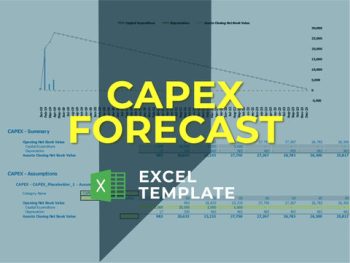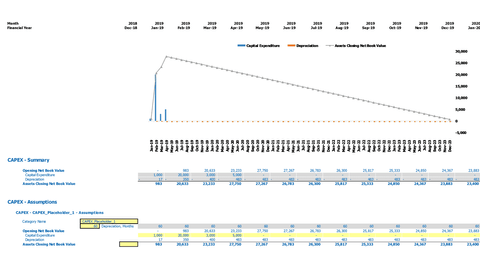- Activity Based Budgeting Case Studies
- Common Challenges of Activity Based Budgeting and How to Overcome Them
- Unlocking the Benefits of Top-Down Budgeting
- Financial Modeling for Capital Expenditure Decisions
- Cash Flow Planning: Benefits and Strategies
Capital budgeting is part of every financial model. So, we have designed 450+ Financial Model Templates Designed in Excel or Google Sheet for different companies which are ready to use and you just need to type the inputs in the yellow cells and you will get the desired financial model. You can also check E-Commerce Financial Model Templates , Food and Beverage Financial Model Templates , Hospitality Financial Model Templates .
After reading this article, you should be able to learn:
- What is capital budgeting and capital expenditure?
- What is Depreciation and Amortization?
- What are the common methods used for capital budgeting?
- Importance of capital budgeting and its uses
- Limitations of the capital budgeting process
- FREQUENTLY ASKED QUESTIONS
What is capital budgeting and capital expenditure?
Capital budgeting is the planning process used by organizations to determine the purchase of fixed assets that have selected from available options. Each asset under consideration is valued using quantitative techniques to make a justification decision. Business Manager always tries to use available resources efficiently and invest in assets/project from where he can generate maximum return. It is an important tool used to assess and compare the opportunities available to invest the organization’s capital.
Capital budgeting decisions typically involve high value investments and overflows of funds for organizations. Therefore, the organization undertakes due diligence of the options available to assess how this investment will be paid out.
Capital expenditure generally known as CAPEX is expenditure incurred by an organization for the purchase of long term assets such as property, plant or equipment, software, license, etc. It also includes expenses incurred on or improving its efficiency. Capital expenditures are usually undertaken by the organization for expansion, introduction of a new product line, entry into a new market, or acquisition of a new business. These expenditures are undertaken based on the capital budget process.
Capital expenditures are incurred to maintain the existing level of operation and also to expand the existing operation of the business. These expenses can be tangible, for example the purchase of buildings, factories and machinery and not such as software, a license or patents. Capital expenditures are recorded on the balance sheet and charged to the income statement using the depreciation and amortization method.
What is Depreciation and Amortization?
Capital expenditures are recorded as expenditures over the life of the asset. Depreciation is to expend a tangible fixed asset over its useful life while amortization is related to the expenditure of the intangible asset over its useful life. Tangible assets may have some value after the end of its useful life and therefore such value is deducted when calculating the depreciable amount. Generally, intangible has no salvage value at the end of its useful life.
Here are the common depreciation methods:
- Straight-line method: This is the simplest and most common depreciation method. Under this method, the depreciation expense for each year will remain the same.
It is calculated using the following formula:
Depreciation = (Cost of assets – salvage value) / useful life
- Depreciation of the equilibrium method: Under this method, the asset is depreciated at the rate specified for each asset class. This result of the method is a higher depreciation at the beginning of the life of the assets.
The depreciation formula is as follows:
Depreciation = Book value each year x depreciation rate
- Units of Production Method : This method depreciates assets based on asset usage such as number of hours used, or unit produced per asset over life.
The formula of the units of production method:
Depreciation expense = (Number of units produced / life in number of units) x (cost – salvage value)
- Sum of Year Digit: This method also charges accelerated depreciation at the start of the assets life.
The formula for this method is:
Depreciation expense = (Remaining life / sum of years digits) x (cost – salvage value)
Accumulated Depreciation: It is the total depreciation that has been charged against the asset since the asset was ready for use. Assets are generally presented on the balance sheet at a lower accumulated amortization cost. This accumulated depreciated amount increases with the increase in the life of the assets.
Common methods used for capital budgeting
The capital budgeting process typically involves the following methods to assess the options available for investing in assets:
- Actual net value:
Net present value is a valuation technique that is simply the difference in present value of cash inflows and cash outflows. Cash outflows are the initial capital expenditures that the organization will pay for the purchase of these assets. While cash inflows are the cash flows generated using these assets. The net present value of all considered assets is compared and the one with the highest net present value is selected. - Stress Analysis:
In this method, the bottleneck machine or work center of a production environment is identified and assets that result in optimal utilization of the bottleneck operation are selected. - Recovery period:
This technique involves determining the period of time required for the asset to repay its initial debit. Simply put, it shows how long an investment will take to repay its own costs. Assets with a lower payback period are preferred for investment. - Avoidance analysis:
Sometimes overhauling the existing asset results in efficiency and/or useful life. This analysis is used to assess whether making such expenditures can significantly understate a company’s total investment in fixed assets. - Profitability index:
This ratio is calculated by dividing the present value of future cash flows by the initial investment of the project. This technique indicates the attractiveness of the project. The PI ratio of an investment is high, it is more attractive. - Internal rate of return:
This technique is used to evaluate capital budgeting projects. It shows the annual growth rate that the project or an investment will generate over its lifetime. The IRR is calculated similar to that of the NPV calculation. The project or asset with a higher IRR is the desirable investment.
IMPORTANT POINT: We have designed a free Excel/Google sheet Capital Expenditure Budget Template where you just need to put your assumptions in the yellow cells. The CAPEX template allows you to split CAPEX with up to 10 different asset classes, making it convenient to populate the template with values. Another handy feature is the CAPEX investment summary, which shows the aggregated values of all projects also reviewing those values on the visual form on the chart.
Download Capital Expenditure Budget Template in Excel
Importance of capital budgeting
Organizations always strive to use available capital efficiently to ensure maximum return on investment, so investing in the capital expenditure decision always requires due diligence and evaluation to select from available options.
Here is the rationale for capital budgeting:
- Capital expenditures are usually long-term decisions and therefore careful consideration should be given to evaluating the available options based on the organization’s goals and strategic directions.
- Capital expenditures once undertaken are usually difficult to reverse without incurring a loss. Equipment or assets are usually customized for a specific organizational need. Reversing such a decision will result in a higher cost to the organization.
- Due to the higher initial cost involved, such decisions should be made with care.
Limitation of capital budgeting
Despite the fact that capital budgeting has a very important role in the decision-making process, however, some challenges of this process are explained:
- Due to the implication of valuation, there is always a risk associated with valuation. Overestimating revenues on one side may lead to loss of capital if actual cash flows are not generated as estimated while on the other side, underestimating may lead to rejection of a project which might have happened. prove beneficial.
- Risk of uncertainty due to the extended time horizon for the capital budgeting process. Factors such as competition, changes in the regularity environment and changes in technology cannot be accurately predicted.
- One of the problems associated with this process is due to the lack of consideration to the time value of money. The payback period is the most common tool for evaluating these types of decisions, but it does not take into account the time value of money.
- Using an appropriate discount rate is also a challenge for capital budgeting. Changes in the interest rate and the cost of capital cannot be estimated with precision.
FREQUENTLY ASKED QUESTIONS
Q. If the capital budgeting process is required by the applicable reporting framework?
A. No. Like other budgeting processes, capital budgeting is also a planning tool used to determine the proposed investment in fixed assets / capital expenditures.
Q. Can capital expenditure be recorded in the income statement?
A. No, capital expenditure is not directly recorded in the income statement as operating. It is charged in the income statement using the depreciation and amortization method.
Q. Is capital budgeting an accounting concept?
A. No, it is not an accounting concept. It is the planning tool used in investment decisions.
Q. What other factors influence the capital budgeting process?
A. Besides the valuation techniques used for capital budgeting, there are other factors such as availability of capital, required return, regularity requirements, degree of competition, risk and uncertainty associated with the project. .
[right_ad_blog]



